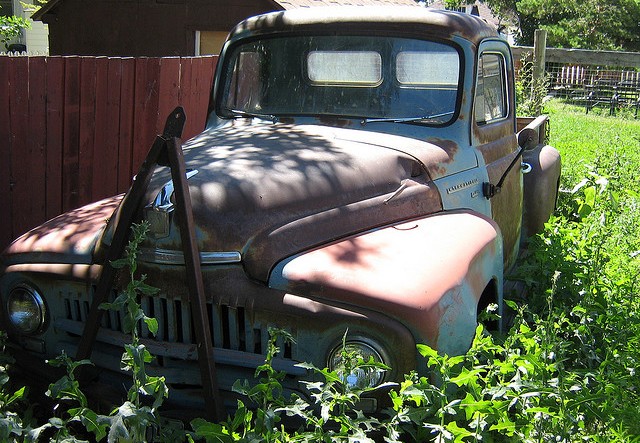Podcast: Play in new window | Download
Subscribe: RSS

No, the weeds didn’t kill the truck, but they are making the point that they will be there after the truck is gone. Zombie weeds, on the other hand, are making a much more aggressive point. (Photo by Dave 7/Flickr)
Farmers across the Midwest and South — those whose crops are not under water or blowing away in a hot, dry wind — are besieged by an enemy straight out of a stupid horror movie: an army of undead weeds that cannot be killed by chemicals. It’s as if you shot the heart out of an attacking enemy soldier and he just kept on coming. Cotton producers in the South have deployed armies with hoes to chop down weeds with stems up to four inches in diameter that shrug off the best herbicides that money can buy.
Industrial agriculture is all about chemicals, and genetically mutilated plants. For decades, it has been all about Monsanto’s Roundup — a glyphosate herbicide that used to kill every plant it touched except those that were genetically engineered to be resistant to it, which are available, at a premium price, from the aforementioned Monsanto. So industrial agriculture has been reduced to soaking the landscape with Roundup, planting it with Frankenfoods that can’t be killed by Roundup, and turning most of the profits over to Monsanto.
But when you drench the landscape with any poison, there are always a few mutants in the population you’re trying to kill that by some accident are immune to its effects. Now that you’ve killed their competition and provided them with an endless cornucopia of their favorite food, they go forth, and multiply. Now who you gonna call?
For exactly the same reasons, indiscriminate use of antibiotics in industrial meat, milk and egg production have blessed the world with unstoppable, untreatable mutant infectious bacteria, MRSA being one example.
The emergence of these zombie weeds was predicted, and has been going on for more than a decade while Monsanto achieved world domination in the seed and herbicide businesses. Its success gave Monsanto lots of cash for advertising and for political contributions, and that is why the cascading, worldwide failure of its Roundup system has been given scant attention by the leaders and journalists of the free world.
A rare exception is a solid story in the Sunday edition of the St. Louis Post-Dispatch that details the deployment of hoes in the cotton fields, and the desperate return to the nasty herbicides of the past for which Roundup was supposed to be — that is, was advertised to be — a benign replacement. Not only is there increasing evidence of the toxicity and persistence of Roundup [see the Daily Impact’s Heading for the Last Roundup 11/12/10], but the entire strategy is unwinding and raising very real prospects of a global crash in agricultural production.
Ironically, the industrial planters quoted in the Post-Dispatch piece profess to be not so worried about the rising costs of dealing with the zombie weeds because prices for their products are so high. Those high prices are a result of the failure of industrial agriculture to keep up with the world’s relentlessly increasing demand for food, after it was promoted and accepted as the only way the world could be fed. Those high prices are spreading misery and death throughout the world, are destabilizing countries (they are a major, albeit largely unrecognized, cause of the so-called Arab Spring), but for the moment are propping up the profits of Monsanto and the formerly high-tech, now hoe-wielding, agriculturalists of America.
Survivor weeds with super stalks can really tear up equipment also. Even things like Canadian thistle will tear up a hay cutter. Relentless tillage is simply making a seed bed for the survivor weed seeds. Seeing pigweed and lambsquarter growing 6 feet high is what drove us to explore no till methods.
And to conclude that the plow, far from being the boon to mankind as it is portrayed, was the guillotine that killed our soil.
And where is the facebook like link ?
Oops. It’s there now, thanks.
If it were me personally, I would look into doing some tests/experiments on using full-strength vinegar…it’s a great weedkiller. I have sprayed undesirable plants at the base with vinegar and they croak. Sprayed it on moss, mushrooms, etc. Makes them croak. Rain dilutes the effect, so you can get plants to grow there later. I haven’t done any soil tests afterwards regaring pH balance or anything, so can’t make any statements there.